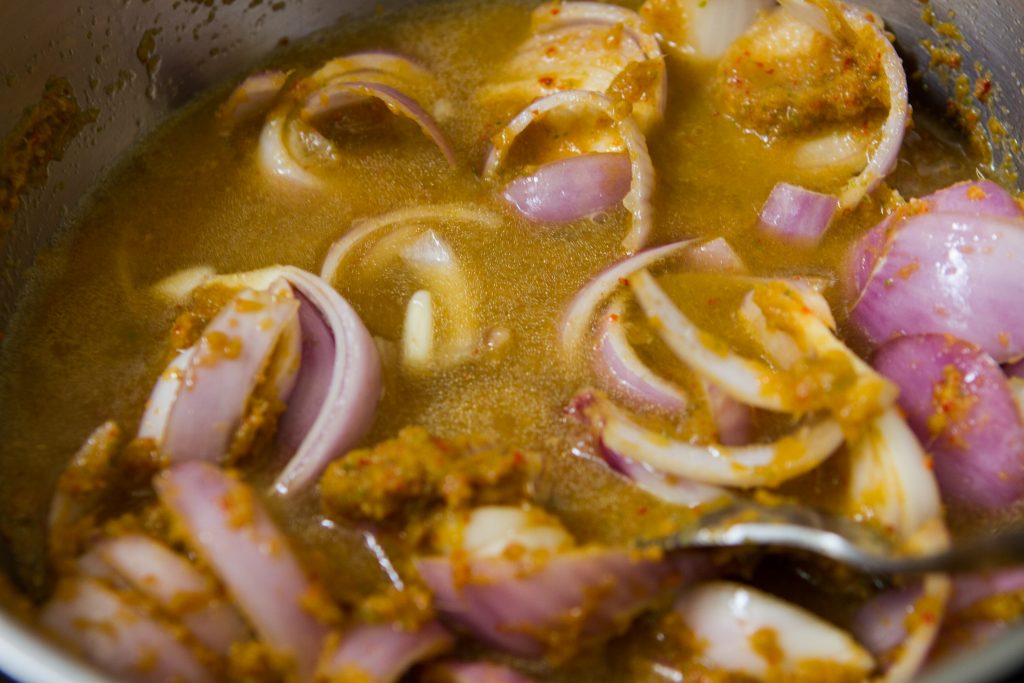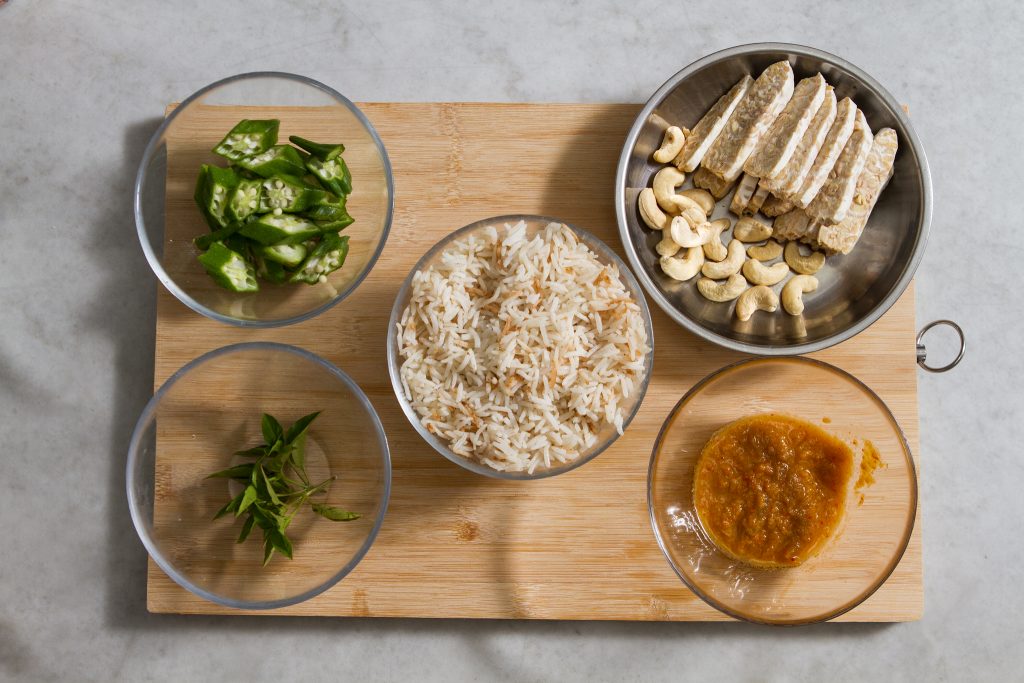
Before I say anything else, I need to write down the caveat for this simple version of vegan nasi lemak.
It is this: it’s borne from the years of wishing that I knew how to make a simple fragrant coconut milk rice with sambal when I was living in the London as a semi famished architecture student. So, most of the ingredients used here should be very easily available even in the UK (and other western markets, I imagine), whether from a regular supermarket or better still, a specialist Asian supermarket. If I could get most of these items in the 90s, I am pretty sure they’re even more readily available now with an even more globally interconnected world.
I will be showing you how to make a relatively straightforward vegan version of this dish. Almost always, most Malaysians make their sambal with some form of seafood (fresh or fermented)- there are plenty of recipes for these out there.
The tools you’d need to have are a blender, a couple of 2L saucepans, a hob (I used two standalone induction hobs), and a kitchen scale if you want to have the exact same measurements as what I made. If you also have a non stick frying pan, that’s a bonus.
Wait, what? Yes, I did say nasi lemak goreng.

I think it was in the 1990s when somebody within or related to my circle of friends (was it you? was it me? I can’t remember) decided that the nasi lemak bungkus on his table was much too cold to the touch, and probably not too fresh, and so he called out to the mamak and said “Macha! tolong gorengkan!” (bro, help fry this up). And so he did, rice, sambal, peanuts, ikan bilis, sliced cucumbers, all in- what a glorious mess.
I imagine that many others might have made similar or even exact requests before then, and after that time. Apparently, these days it’s even sold as a regular dish at certain road side eateries.
We are going to make a home-made vegan version of that, after we have made the basic nasi lemak dish itself.
Part 1: The Nasi lemak
A. The nasi lemak, the coconut rice, itself.
We will be cooking this in a 2L saucepan over an induction hob.
Ingredients

250g to 275g basmati rice
5g pandan leaves, knotted (3 to 5 pieces)- if you can’t get this, just skip it.
50g old ginger (weight after peeling)
5g salt
200ml boxed UHT coconut milk
Method
1. Put the rice into the saucepan. Wash and rinse the rice. Twice. Pour only the water away.
2. Pour the coconut milk in and with a spoon, mix it with the rice. Top up with water until the liquid covers the rice about 5 to 10mm.
3. Add in the ginger and the pandan leaves.
4. Put the saucepan with the rice mix over the hob and turn on at full heat. Keep stirring the bottom with a spoon until the mix starts to boil dramatically.
5. Reduce heat to the lowest possible. Cover the saucepan with the lid and let it simmer for 16 minutes. After the heat has been turned off, keep the lid on for another 5 to 10 minutes.


B. Vegan Sambal
This is going to burnnnn…. be very careful when handling chili padi, for the capsaicin released from the inside of the fruit can stay on your hands for hours, leaving you with a feeling that you are being burnt alive throughout that time. De-seed the chilli under running water and wash your hands constantly while de-seeding, or maybe wear latex gloves.
Ingredients
170g chili padi (about half green, half red).
113g total weight, after seeds removed from about half of them. You can use milder cultivars.
74g old ginger (after cleaning and peeling)
70g galangal (after cleaning and peeling)
50g garlic (after cleaning and peeling)
325g big red onion (after cleaning and peeling)
120ml cooking oil160ml water for blending(less than this is better)
300 to 320ml water for cooking.
15g salt
35g sugar
Juice from 208g key lime (4 to 5 fruits).

Method
1. Into the blender, chuck in the chili, ginger, galangal, garlic, and salt, and some of the water, and then blend into paste. If it fails to blend, keep adding water incrementally.


2. In a 2L saucepan, on low heat, add in 120ml or about 8 tbsp of cooking oil. We are not going to try to be culinary tv show people here, so before the oil completely heats up, add in the blended ingredients, and mix it well with the oil. We are adding the blend in before the oil completely heats up so the hot oil doesn’t blow up upon contact with a water based liquid. We are trying to not only avoid a mess around the kitchen that needs cleaning up, but also potential scalding injuries.
3. Now, you’ll have to keep stirring the mix until it begins to evaporate fragrantly. You keep stirring it so the bottom doesn’t burn.

4. Stir in the onions and stir until softened.

5. Add in 300 to 320ml water into the mix and bring to boil. Stir in the sugar.

6. Bring down the heat to the lowest, cover the saucepan with lid, and allow the mix to simmer down (yes simmer down, until the water content has evaporated quite a bit) for at least an hour, with oil beginning to appear. Turn off the hob.
7. Taste test. Not salty or sweet enough? Heat up the mix again,and add in a bit more of either to adjust to your taste. Warning: It will be spicy.
8. Pour in the keylime juice, and stir to mix. Yes, that is a lot of sambal. If you are going to put in so much work, might as well make a little bit more. You can jar this and eat it with other future meals, or cook other dishes with it.
C. Accompaniments: Okra, tempeh, and cashews
You can adjust how much cashews (or other nuts) and tempeh you want to serve. I replaced blanched cucumber slices with blanched okra. 50 seconds in rolling water seems to work well.
Ingredients
Tempeh, cut to thin slices.
50ml cooking oil (about 3 tbsp cooking oil. You can use more)
Some cashew nuts (I think I used 50g worth)
1 teaspoon salt
Optional: 2g thai basil for garnishing.
Method
1. In a frying pan, heat up the cooking oil in low heat. Arrange the sliced tempeh on it and let it slowly simmer until the bottom side browns. Then flip over and repeat . Remove when done and set aside. (I used chopsticks to do all of this)

2. In the same oil, fry the cashews. Keep turning them to prevent charring. When it looks a bit brown, remove and set aside.
3. You can mix the oil from this into the sambal. Remember to stir it in, if you do.
4. If you don’t have another saucepan to blanch the okra, you can reuse the frying pan again. In this same frying pan, fill halfway with water and heat up the water to boil. Put in the okra (as many pieces as you like to serve, but don’t overfill the pan because we want them as a single layer). Blanch for about 50 seconds, then remove and set aside.
D. Nasi Lemak, Assemble!
If you can get hold of banana leaf, wash to clean it (then wipe dry) , put it on a plate or a wood platter and use it to serve your nasi lemak on. You can style it in any many different ways- I just did it in the most typical Malaysian slop-fest way.

Part 2: The legendary Nasi Lemak Goreng (spicy fried coconut rice)- Vegan version.
I think the real thing itself was fried with at least one packet of nasi lemak bungkus, but we will be making a vegan version of this with just one bowl of the coconut rice, to serve one person.We are going to be frying this in a frying pan over an induction hob. Yes, you can indeed fry rice at home without a round bottomed wok and big open flames. You are not operating a fast moving Asian restaurant.
The sambal and the nasi lemak already contains salt, so unless you really like your food very salty, there’s no need to add more.
Ingredients:
185g or 1 rice bowl worth of coconut milk rice.
42g okra (2 pieces), sliced
40g to 60g sambal (You can use a lot more than this, but too much will result in a rather wet fried rice that’s also too spicy)
Tempeh, sliced
2g thai basil
25g cashew

Method
1. In a frying pan, heat up about 30g of cooking oil. Place the sliced tempeh on and fry till one side is golden brown, then flip over and repeat. Put in the cashews after flipping the tempeh. Remember to prevent the cashew from charring.

2. After removing the tempeh, with the cashew beginning to start browning in the pan, add in the sliced okra, and let them fry.

3. Raise up the induction power to maximum frying heat, Add in the rice, and then the sambal.

4. Stir to mix and stir fry it until smoke vapour rises into the air. It’s done.

5. Serve it hot and style it in any ways you think makes it look better than delicious. I like my tempeh crispy, and so they’re served on the side.

These are great, easy, recipes and easy to remember. Just delicious and perfect for any one who is missing good Malaysian food. It will come out great if you follow the instructions exactly. Follow me on my Instagram here or check out my other recipes on Butterkicap.
